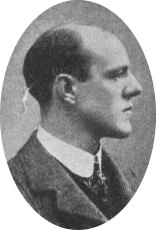Top Qs
Timeline
Chat
Perspective
Frank Reynolds (artist)
British artist (1876–1953) From Wikipedia, the free encyclopedia
Remove ads
Frank Reynolds (13 February 1876 – 18 April 1953) was a British artist. Son of an artist, he studied at Heatherley's School of Art.[1] His work was part of the painting event in the art competition at the 1928 Summer Olympics.[2]
Remove ads
Biography
Summarize
Perspective
Frank Reynolds was born in Hammersmith, London on 13 February 1876.[3] He had a drawing called A provincial theatre company on tour published in The Graphic on 30 November 1901. In 1906, he began contributing to Punch magazine[1] and was regularly published within its pages during World War I, noted for his anti-Kaiser illustrations in Punch.[4] A collection of 199 of his illustrations is in the Punch archives.[5]

He was well known for his many illustrations in several books by Charles Dickens, including David Copperfield (c. 1911),[6] The Pickwick Papers (c. 1912) and The Old Curiosity Shop (c. 1913).[4] He succeeded F. H. Townsend as the art editor for Punch.[1]
Reynolds was one of the leading illustrators selected by Percy Bradshaw for inclusion in his The Art of the Illustrator (1917-1918) which presented a separate portfolio for each of twenty illustrators.[note 1] He was also a prolific watercolour painter and was a member of the Royal Institute of Painters in Water Colours from 1903. He continued to illustrate in black and white or in colours all his life. He became known in the 1930s and through the Second World War for characters called The Bristlewoods.[1]
One of his more notable works is entitled Jingle.

His journal contributions included
He died from pneumonia at Holloway Sanatorium in Surrey on 18 April 1953.[3][9]
Remove ads
Notes
- The portfolio contained: a brief biography of Reynolds, an illustration of Reynolds at work in his studio, an explanation of Reynolds's method of working. This was accompanied by a plate showing an illustration typical of his work and five other plates showing the work at five earlier stages of its production, from the first rough to the just before the finished drawing or colour sketch.[7] Reynolds's illustration shows a disgruntled traveller accompanied by his wife and child.[8]
Remove ads
References
External links
Wikiwand - on
Seamless Wikipedia browsing. On steroids.
Remove ads

